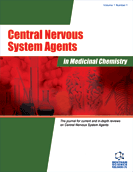
Full text loading...
The accumulation of tau-containing neurofibrillary tangles and beta-amyloid deposits has been identified as the hallmark of Alzheimer's disease. Alzheimer's disease (AD) is a hereditary and neurological condition that can result in non-amnestic cognitive decline in less common forms and amnestic memory loss in its classic form. While Alzheimer's disease is the most prevalent cause of memory loss in middle-aged and older adults, other neurodegenerative and cerebrovascular disorders can have an impact on the disease's clinical course. Designing multi-target-directed ligands (MTDLs) is a very promising modern approach. This methodology was designed specifically for treating disorders with complex pathological mechanisms. Among these disorders is Alzheimer's disease (AD), which is currently the most prevalent multifactorial neurodegenerative illness. Increased amounts of the amyloid βpeptide (Aβ) and hyperphosphorylated tau protein, together with the loss of neurons and synapses, are linked to Alzheimer's disease (AD). Additionally, there is evidence that the pathophysiology of this condition is influenced by oxidative stress, metal ion dysregulation, inflammation, and failure of the cell cycle regulatory system. Since Alzheimer's disease (AD) is a multi-factor illness, there are many attractive targets for the development of anti-AD medications. These molecules can be useful in treating AD since they are multi-target-directed. This review focuses on the discovery of dual and multi-acting anti-AD drug candidates, especially hybrids made by combining chemically active moieties that function against distinct targets. The first group of substances consists of cholinesterase inhibitors with extra properties or those that function as multiple binding site inhibitors. Natural products also provide numerous options for slowing the progression and symptoms of many diseases, including Alzheimer's Meanwhile, Natural chemical structures with the following characteristics: alkaloids, sterols, triterpenes, tannins, flavonoids, polyphenols, and antioxidants as well as anti-inflammatory and anti-amyloidogenic properties. We provide an overview of Alzheimer's disease pathophysiology and therapy targets in this study. We also show several isolated chemicals and medicinal plants that are used to treat and prevent the symptoms of Alzheimer's disease.

Article metrics loading...

Full text loading...
References


Data & Media loading...

